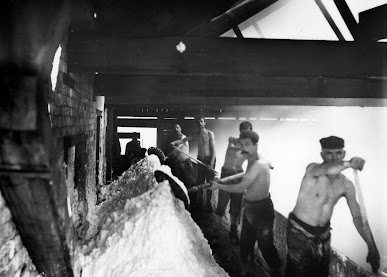by Deborah Swift
Salt comes from two main sources: sea water, and the mineral halite (also known as rock salt). Salt is something we take for granted nowadays, forgetting that the term for our pay, the salary comes from the Latin salarium, originally denoting a Roman soldier's allowance to buy salt.
Near where I live in Lancashire and Cumbria, there is a long history of panning for salt in the Morecambe Bay. In 1748, William Brownrigg’s The Art of Making Common Salt mentions ‘sleeching’ on Morecambe Bay. Sleeching, I discovered, is scraping up salt-impregnated sand and silt, then watering out the salt to produce a concentrated brine, then boiling in 'saltcotes' – small huts installed with lead pans over a fire.
But as canals and railways allowed the cheap transport of salt from inland mines and abroad, coastal salt-making gradually faded away, and by the 1860s it had almost entirely disappeared. One of the biggest producers of salt was Lion Saltworks in Cheshire and you can find a wonderful post and pictures,like the one above, about it here.
Norwich, Nantwich,
Middlewich
Many towns and cities in England end in –wich (or wych) and these are traditionally
associated with salt production. The
suffix -wich derives from an Anglo-Saxon word meaning roughly "a dwelling
or fortified place" and usually these were places with trading activity on low-lying coasts or on salt marshes, so many of these towns were also active in
producing salt, which was a major and lucrative export.
White Gold – Salt from
sea water
New Forest Salt
Lymington in the New Forest, on the Solent estuary, is a
town that began as an Anglo-Saxon village and is recorded in the Domesday Book
as "Lentune". From the Middle Ages and up to the 19th century, Lymington was
well-known for its salt making
On a visit to Lymington in the 1690's traveller Celia
Fiennes writes of Lymington as having
a few small ships, but “the greatest trade
is by their salterns” and she gives details of how the seawater was pumped through
pipes into iron or copper pans situated into the salt-houses where it was
evaporated away by boiling rapidly over coal fired furnaces. A vast amount of salt could be made in a single pan beneath which the furnace was
kept blazing away all day and night (see the picture). By the middle of the eighteenth century
there were about one hundred and fifty active salt pans.
Read more about Celia Fiennes here, on the English Heritage site. The picture of the boiling off of water over a furnace is from National Gallery of Scotland.
A Tax on Salt
Salt was a precious and valuable commodity used the world
over, as it is an essential nutrient. In 1641, during the commonwealth period, the previously abolished salt
tax was reintroduced to raise money for Parliament. However the tax was revoked
on the King’s return in 1660 and not reinstated until 1693 under the reign of
William III. The tax was originally set at two shillings a bushel on foreign
salt, but only one shilling on native salt to protect English salt workers.
Salt Wars
In the early 17th century, while well-known nutmeg wars were
fought between Dutch and English merchants over imported and exotic "East
Indian" spices, a different but equally intense rivalry erupted as traders
in the Netherlands tried to secure their salt supply for the processing of herrings,
butter and cheese.
The Baltic and Poland had extensive salt deposits, but the
best supplies were controlled by the Spanish monarchy, in Portugal and the
Caribbean, where salt more suited to herring was produced. Throughout the 17th
century, the problem of salt supplies determined the Dutch attitude to the Spanish
and Portuguese, and affected these empires’ prosperity in the Dutch
"Golden Age".
https://www.youtube.com/watch?v=DFOxbmgr4so
Or read Mark Kurlansky's Salt
Deborah Swift is the author of nine books set in the 17th Century, as well as others set in the 20th Century. Find her at www.deborahswift.com or chat with her via Twitter @swiftstory





No comments:
Post a Comment